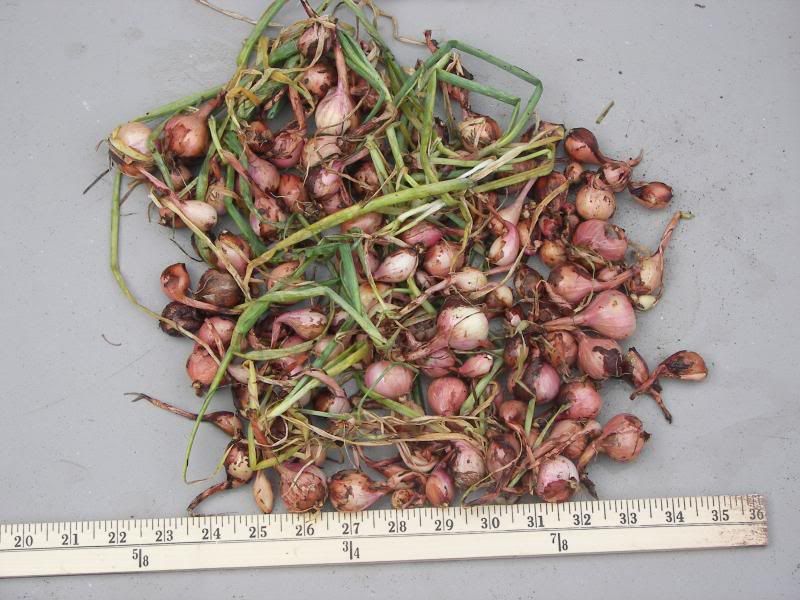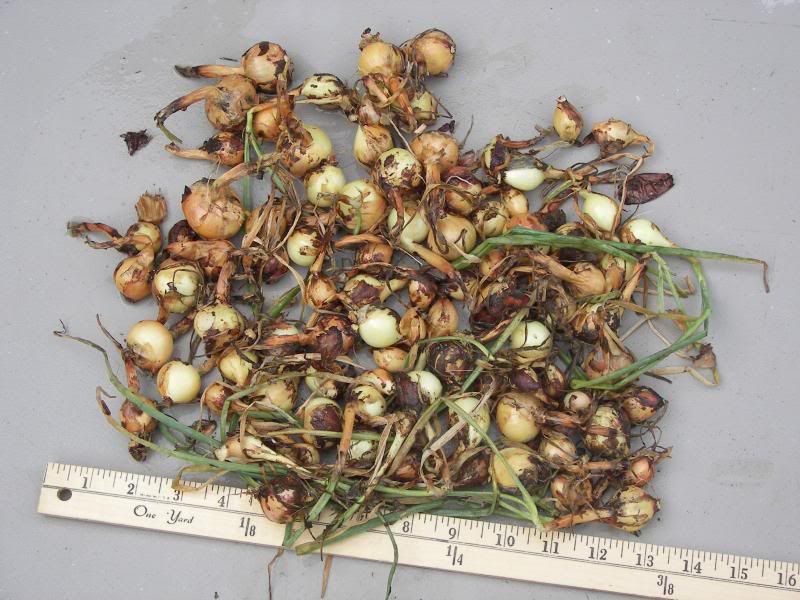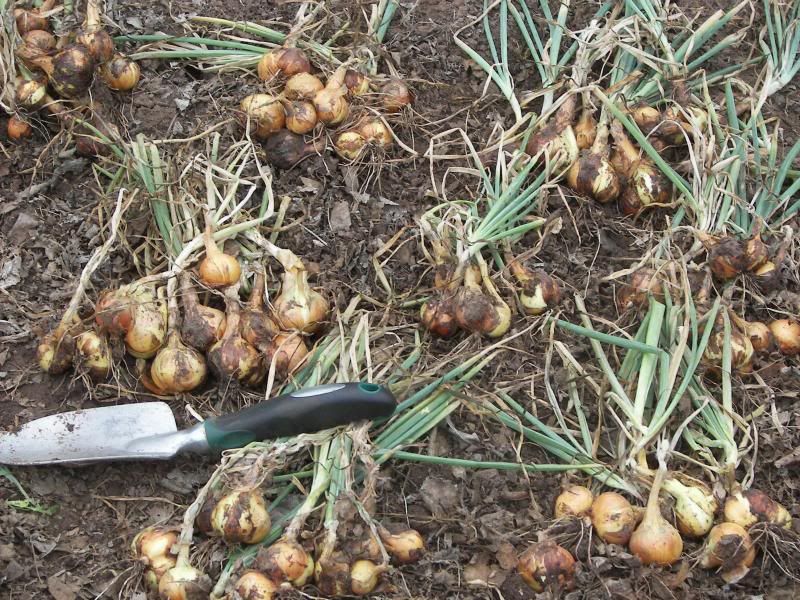|
|
Post by billw on Nov 9, 2013 18:52:30 GMT -5
I can recommend cool temperatures and plenty of water, because ours flower every year and that is what we have. They're flowering now. I'll go check to see if any seed is forming. I haven't looked at them for a while.
That said, I thought that multiplier onions and potato onions were synonymous, so maybe we're not talking about the same thing.
|
|
|
|
Post by templeton on Nov 10, 2013 17:17:46 GMT -5
I'm growing three different sowings of Kelly's Green Mountain spud onion seed. Two lots were sown in SH late summer, one lot in the ground over winter, and the other in pots in a sheletered location, then planted out in SH spring.
The third lot was seed I held back in case of calamity, these were sown in late winter in greenhouse, and recently transplanted out.
There is considerable phenotypic variation within each batch.
from the first, some growing as singles, others dividing op to eight times, and one flowering.
From the second, again, dividers and singles
From the third, still very small, 10 green ones, two pale yellow - and not thriving.
|
|
|
|
Post by zeedman on Nov 11, 2013 0:39:41 GMT -5
I can recommend cool temperatures and plenty of water, because ours flower every year and that is what we have. They're flowering now. I'll go check to see if any seed is forming. I haven't looked at them for a while. Thanks, Bill. Being fairly new here, I'm not sure of your location or climate (I'm guessing Pacific Northwest?). I hate that the last site upgrade [downgrade?] deleted location, especially when this site has so many international members. ![]() Were your onions planted in Spring or Fall? High winter kill for Fall-planted potato onions is the biggest obstacle here. Even with mulch, the losses were severe... at best, I could only get enough from the survivors to replace what I had planted, so I gave up growing them. It might be that I will have to put up with that winter kill in order to get flowers, but given the high cost of the stock, I would prefer to find a less destructive way to stimulate flowering. I'm hopeful that a long period of chilling (in the fridge, or in the garage once the sub-zero weather has passed) will cause at least a few to bolt when planted in Spring. Maybe some of Kelly Winterton's onions will flower more easily than the commercially available yellow stock. I've heard it often said that the two are synonymous, but the potato onions I grew - and which I remember from my childhood - were much different than the two multipliers I am growing now. The bulbs from mine are small, generally about 1-1.5 inches across at the largest... not really large enough to be easily useful. One has yellow skin & white flesh, the other reddish brown skin & pink flesh. They form in clusters of 3-10, with 5-6 being typical; the yellow (obtained from some Hmong gardeners) is the more productive of the two. The foliage is diminutive, only about a foot high, with leaves just larger than chives. The leaves & flower umbels of the two have pronounced differences. Both are exceptionally winter hardy & reliable in my Zone 5 climate, even with no protection. Because they multiply quickly, are hardy, and can store well over the winter months indoors, they could be good subsistence onions... but I would like to increase their size. The potato onions were larger, more like 1.5-2 inches across, and generally in clusters of 3-4. The leaves of the potato onions were much wider, roughly the same width as onions grown from plants or sets, but slightly shorter. I remember there being white, yellow, and red potato onions when I was young. Only the yellow is still available; based upon several threads I have seen searching for the other two, they might be extinct. They were displaced over the years by modern onion varieties - but I don't think that displacement is solely responsible for the disappearance of the other colors. It is possible that the other colors were even less hardy, and their high winter mortality slowly destroyed the stocks of the few still growing them. On a side note... the long bulb storage life gives me a lot of latitude as far as planting date. There are significant differences in growth when the bulbs are planted at different times. Fall planting produces the largest clusters & best bulb size, and at least some will flower (nearly all some years). Spring planted, both bulbs & clusters will be slightly smaller, and those onions are very regular in size - but no flowers. I planted some in mid-Summer this year; those onions were a year old, and about 1/2 of them were still alive! Each onion formed a clump of scallions, but no bulbs. I've left them in the ground to winter over; it will be interesting to see whether the plants will split again in Spring, and whether the mid-Summer planting forms more or larger bulbs than those which are Fall planted. Which is, I realize, OT for the discussion of walking onion seedlings - my bad. This is a photo of the one I suspect is a Catawissa/Hmong onion cross, from a Spring planting:  And the Hmong multiplier (also Spring planted):  |
|
|
|
Post by steev on Nov 11, 2013 0:47:28 GMT -5
Now I wonder what is the "original" Hmong climate; I've tended to think it temperate\tropicalish.
|
|
|
|
Post by zeedman on Nov 11, 2013 1:46:07 GMT -5
Now I wonder what is the "original" Hmong climate; I've tended to think it temperate\tropicalish. Tropical climate; but that just makes the performance of their onions more confusing. When I lived in San Diego, I grew some onions that had been given to me by the Hmong there. They were used primarily as scallions, and would not form bulbs... but then, I did plant them as a Winter crop there, so very short days. I lost that stock when I moved, but the Hmong onions I have now - when planted in mid-July - exhibited the same behavior. So it appears that this is a long-day onion. Makes me wonder where the original stock came from... perhaps they were acquired in the course of their relocation, rather than from their homeland? There are a lot of Hmong gardeners in a community garden project sponsored by my county, I'll try to make some inquiries there next summer. |
|
|
|
Post by steev on Nov 11, 2013 3:15:59 GMT -5
Is it not wonderful how our species moves around and takes other species with us?
Although there are many Hmong in California, I never understood why so many wound up in the Mid-West. For that matter, being in California, I've never understood the concept "Mid-West". I mean. historically, I get it, but these days, really? Isn't that like Utah or Nevada, the last hundred years or so?
In any event, I've thought the Hmong to be mountain people, so perhaps less tropical, though certainly not snow-acclimated.
San Diego is a very specific and special climate; the only mainland banana plantation is near there; anona is also grown near there as a commercial crop.
|
|
|
|
Post by ilex on Nov 11, 2013 18:19:07 GMT -5
That said, I thought that multiplier onions and potato onions were synonymous, so maybe we're not talking about the same thing. I think the main confusion is between walking onions and potato onions. Walking onions are A. cepa x fistulosum, while potato onions are A. cepa. I feel multiplier onions is more generic, and includes both walking onions and potato onions (and french shallots). I guess you can think of bunching onions as multiplier onions too, in some way. |
|
|
|
Post by ilex on Nov 11, 2013 18:31:53 GMT -5
I remember there being white, yellow, and red potato onions when I was young. Only the yellow is still available; based upon several threads I have seen searching for the other two, they might be extinct. They were displaced over the years by modern onion varieties - but I don't think that displacement is solely responsible for the disappearance of the other colors. It is possible that the other colors were even less hardy, and their high winter mortality slowly destroyed the stocks of the few still growing them. I've got a red one, got it from the UK. You will like this pdf document: IPK shallots. |
|
|
|
Post by zeedman on Nov 12, 2013 1:43:27 GMT -5
Thank you, Ilex, that was indeed interesting; I've bookmarked it for future reference. One of the onions in the link resembles the Hmong onions in habit, bulb size/shape & skin color, although some of the red-fleshed cultivars more closely resemble the bulb shape. I notice that they refer to them all as "potato onions", although their size is similar in size to the ones I grow. This is a better photo, of the Fall planted onions. The clusters in the photo are "best of"... the average clusters are typically smaller than these, but they get better each year.  |
|
|
|
Post by templeton on Nov 12, 2013 16:22:49 GMT -5
I note that document distinguishes between shallots and potato onions. On what criteria?
|
|
|
|
Post by ilex on Nov 12, 2013 17:55:01 GMT -5
Ilex, what did you cross them with? I'm very interested in hearing the technique(s) used to make them flower. The only potato onion that flowers for me is green mountain, which is a mid day onion. What I do is always let flower a couple plants of any onion I have, close to these. I also grab flowers of common onions and rub them onto the potato onions every other day. I think I mostly used a sweet short day onion called "babosa valenciana", but who knows, I didn't pay much attention nor took notes. That just was what I had in hand, and I just wanted to get some seed. I don't do anything special to make them flower, I just get one or two that flower out of ... maybe 60? I plant anytime from September to March. Early plantings make much bigger nests with more onions (I've gotten 1.6 kilos per nest). Later plantings probably make bigger onions. I should test optimal planting time. Some research has been done on making shallots flower. I feel potato onions are just shallots with a classic onion shape. The only one that looks different is the French grey shallot. I think it is related to the variety, plus not well understood factors, like stress. |
|
|
|
Post by ilex on Nov 12, 2013 18:02:35 GMT -5
|
|
|
|
Post by zeedman on Nov 13, 2013 19:49:24 GMT -5
 1.6 kilos = about 3.5 pounds in one nest??? Dry weight, not counting leaves? Wow!!! If the average yield per nest is half of that, you are getting subsistence-level onion crops. Although I want to breed mine larger (which Kelly has inspired me to believe is doable) I would gladly take such a yield. |
|
|
|
Post by richardw on Dec 5, 2013 3:23:24 GMT -5
today ive started removing any bulbils that dont have any flower heads   |
|
|
|
Post by templeton on Dec 5, 2013 3:34:05 GMT -5
Gave the bulbil removal thing a good effort last year for one viable seed - I'll wait until my young plantings of various lines mature a bit, and see what happens - too many projects on at the moment, so I'm tempted to let it rest this year.
|
|